For the past two weeks our lectures on how people affect the marine ecosystem have changed my perspective on awareness of sustainability practices. Living in Bellingham, Washington for the past 5 years has opened my eyes to some sustainable practices such as ‘green building’ where homes and any other city building are built to be energy efficient. This efficiency is achieved by the use of solar heat instead of electric heat, and the design is made to control loss of air, heat, and moisture. Bellingham also offers organic food products at most of the grocery stores that come from nearby organic farms. Great practices such as organic delivery bins are encouraged where fresh organic fruits and vegetables from local organic farms are delivered right to your door. For people who usually rely on their car, the delivery bins allow it so no fuel is wasted and organic farms are supported. You can check out their mission at http://www.dandelionorganic.com/about.htm. It seems to me that their business should be mimicked by others in as many places as possible!
Recently we also had the opportunity to contribute to a 20 acre organic farm called Sweet Earth Farm on San Juan Island. Here is a picture of us removing the weeds that were suffocating the orchard! 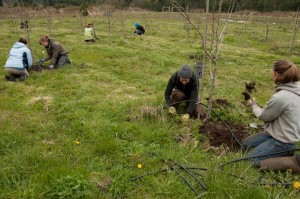 We learned about how they avoid using nonrenewable resources, chemicals and other artificial substances in order to efficiently grow their crops. It got even more interesting when the owner would tell us about other organic farmers that have made 100’s of people food from just a small acre of land using permaculture practices. Permaculture is a sustainable land use design that is based on natural ecology. This design uses what is available in nature in order to maximize the use of the land, minimize the work needed to maintain it, and restore the environment. At first I speculated whether or not this method could actually supply a large sum of people enough food for a few months. She made me more of a believer by sharing more stories of other farmers who have been successful in this field of agriculture. Supposedly in Paris a small plot of land using the permaculture design was able feed the whole city! How amazing is that? I can’t recall the name book that claimed this incredible story as true, but if you want proof I could go back and find out! This made me even more interested in her farm and way of living. It seemed so different from the norm and exactly the way farming should be. She also made her own ointments, lotions and tea from an herbal garden next to her house. All of these self sustainable practices definitely sparked my own thoughts about creating an organic garden that I could live off of and be comforted by the fact I would be contributing to instead of harming the environment.
We learned about how they avoid using nonrenewable resources, chemicals and other artificial substances in order to efficiently grow their crops. It got even more interesting when the owner would tell us about other organic farmers that have made 100’s of people food from just a small acre of land using permaculture practices. Permaculture is a sustainable land use design that is based on natural ecology. This design uses what is available in nature in order to maximize the use of the land, minimize the work needed to maintain it, and restore the environment. At first I speculated whether or not this method could actually supply a large sum of people enough food for a few months. She made me more of a believer by sharing more stories of other farmers who have been successful in this field of agriculture. Supposedly in Paris a small plot of land using the permaculture design was able feed the whole city! How amazing is that? I can’t recall the name book that claimed this incredible story as true, but if you want proof I could go back and find out! This made me even more interested in her farm and way of living. It seemed so different from the norm and exactly the way farming should be. She also made her own ointments, lotions and tea from an herbal garden next to her house. All of these self sustainable practices definitely sparked my own thoughts about creating an organic garden that I could live off of and be comforted by the fact I would be contributing to instead of harming the environment.
Our last lecture before voyaging out to sea on the catamaran was presented by Val Veirs and David Bain on the effects of cars on killer whales. Who knew that there is actually a strong link between the two? One of the reasons cars harm the whales is by the construction of roads. Roads typically are built to get people from one place to another, without thinking of what could be destructive to the surrounding marine life. How exactly do roads harm surrounding marine waters? Roadways that are built around streams create a larger impervious service. This service includes cement parking lots, crowded neighborhoods and anything that will decrease the soil band around streams. This soil is vital to the health of  streams because it is needed to filter the incoming water from these impervious services that sometimes contain waste, chemicals, and/or fossil fuels that leak from cars. The San Juan Islands in particular are known to have a very thin layer of soil, creating an inefficient filter system on the land. This filter system is important for the health of marine animals because anything that filters into the stream is brought to the ocean, where it is consumed by the fish that are eaten by the whales. People tend ignore the fact we live around a complex marine ecosystem that is sensitive to changes.  Another reason cars are harmful to killer whales is by the construction of low bridges that are built in places where the orcas typically travel through. An example of this situation was when the Hood Canal bridge was reopened in 2009.  It just so happens that around the time it was reopened the orcas started avoiding this passage. There aren’t many cases where bridges have this effect on the whales, but there are many accounts of fossil fuels contaminating marine waters. It is apparent that people need to raise awareness on the harmful effects of fossil fuels on the marine ecosystem so that alternative fuel options can be popularized!
Read More
Do you ever think about where your food comes from? I don’t mean the supermarket versus the local farmers market…I mean where it REALLY comes from. For instance, did it grow on a tree in an orchard or root itself deep in the soil? I imagine most my age and older could easily tell you where most basic fruit and vegetables come from. Can we say the same about the generation entering third grade? Do they know that corn comes on a cob tightly packed in neat rows? How about that it is cushioned by fine silk like hairs and wrapped in blade shaped leaves? Do they know that this unit is called an ear?
I often wonder how many people have been to a farm and seen how much work goes into each plant to get a piece of fruit. As a farmer you hope that your hard work brings large yields. There are many factors that contribute to yield. It begins with picking the piece of land and thinking about what you may want to plant there. Water availability, access to the sun, and whether it is a forest or grassland are all great things to consider. However, the soil is really the most important, both in quality and quantity. The soil has to be loose enough for roots to penetrate, while holding in appropriate amounts of moisture without eroding away.
A visit to Sweet Earth Farm on San Juan Island got us down and dirty working directly with the soil. We talked about what it means to be organic and the different variations it encompasses. Large scale industrial farming uses  herbicides and pesticides while organic farms do not. You are probably thinking aren’t you looking for whales? You don’t need to be a researcher to know they don’t sprout out of the ground. (Although that would make our job a lot easier!)  So, how does a farm fit in?  Well as a great philosopher of my childhood once said, we are all connected in the circle of life.    Lion King – Circle of Life
It is true in this case too. Those chemicals used on farms may be directly sprayed onto the crops. Some may go into the air, but eventually it all settles into the soil when the plants decompose. The soil acts as a natural filter, but many times those compounds sneak through. This happens when the soil depth is not great enough to allow for proper filtration.  After passing through the soil, these herbicides and pesticides go into the ground water. This water and its contaminants may feed a stream or lake that is a water source for the local town, but can also go from those rivers into the ocean.  In areas where farming happens along the coast, water can run directly off the soil into the surrounding ocean environment.  Now these chemicals are coming into contact with our beloved whales and their food.  (For more on what is invading their environment click here.)
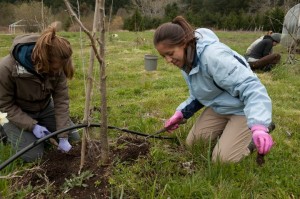
~ photo by Carlos Sanchez
Sweet Earth’s land is still fairly wet at this point in the year, so most of the planting still needs to be done. The orchard however is there year round through all the elements of the seasons. It was our job to cut back grass and weeds around the base of the tree. We were attempting to clear out the soil around the tree roots to give them space to grow. Most of the weeds require complete removal of the roots, so we did our best. Moving the dirt around you could see all the content creepy crawlies. They too live off the soil. Actually, they make the soil by aiding in the break down of the organic (plant) matter that falls into their surroundings. All of these small parts make the soil rich and fertile. The quantity issue is a little harder to address on the island because most top soil is less than a foot deep. Over the years, much has likely drifted off the banks and down to the ocean floor. Without trying to dig that up, a way to increase soil depth is to add more organic matter. Sweet Earth adds a mixture of compost and manure to increase both quantity and quality.
Looking back, one of my first dinner conversations with Mandy was the lack of a compost bin in the Dining Hall at the Friday Harbor Labs. Often after a meal, food scraps were left on our plates. Regardless of why they were left, they all ended up in a trash can next to the rack for dishes and trays. Compostable cups available for drinks through out the day are also put into the trash. Those can cost about 10 cents more than similar cups (see compostable cups versus regular cups).  Think back to when you were a kid, your parents may have said you needed to finish all of your food because there were starving children in some other part of the world. It is not realistic to ship the food to them, but it doesn’t have to go into the trash. Try composting!  Afterall… It is a great way to turn those left overs into something useful.  Plus, you can see if those Sun Chip bags really do compost or how long it takes until a compostable cup becomes unrecognizable.  Even if you don’t garden, you can find a local gardener or farmer who would appreciate your compost pile.  Sweet Earth said they could definitely use more compost, so if you are local you could donate there. If not, ask around. You will likely find a place in need. Some cities even have large scale compostable options (http://www.findacomposter.com/index.php).  Here are a few sites to get you started.
It is a great way to turn those left overs into something useful.  Plus, you can see if those Sun Chip bags really do compost or how long it takes until a compostable cup becomes unrecognizable.  Even if you don’t garden, you can find a local gardener or farmer who would appreciate your compost pile.  Sweet Earth said they could definitely use more compost, so if you are local you could donate there. If not, ask around. You will likely find a place in need. Some cities even have large scale compostable options (http://www.findacomposter.com/index.php).  Here are a few sites to get you started.
http://compostguide.com/composting-tips/
http://www.sunchips.com/resources/pdf/SunChips_compost.pdf
http://www.urbangardencenter.com/composting-guide/composting-guide.pdf
http://www.plantea.com/compost-materials.htm
Once you get your first batch of usable rich soil, you may want to start gardening just so you can use it.
Happy composting and growing,
~Emalie
Read More
Yesterday we returned from our first week at sea on the Gato Verde! It was an absolutely fantastic week, even though the orcas managed to elude us. We went where no Beam Reach group has gone before: all the way around Whidbey Island via Saratoga Passage and through the narrow, turbulent Deception Pass! In case you didn’t know, Whidbey Island is BIG! In fact, it’s the largest island in the state of Washington, and the fourth largest in the lower 48 states. It took us several full days of cruising and a 5:30 AM hail-and-rain-filled departure from anchorage to make it all the way around.
However, we got an incredible taste of the marine life of the Salish Sea. We were treated to sights of river otters, harbor seals, California sea lions, Stellar sea lions, harbor porpoises, gray whales, and even an elusive minke whale! After shooting through Deception Pass, we surprised a California sea lion, who popped up right in front of our boat and proceeded to glare us down for the intrusion. We got to watch a gray whale slowly feeding up and down the coastline. Our first cetacean encounter of the trip was of a minke whale breaching at least five times in quick succession in Admiralty Inlet. I have seen a lot of minkes on various whale watching trips on the East Coast. Usually they just pop up a few times and then disappear. I have NEVER seen one breach. This was most certainly the highlight of the trip for me so far.
However, we were confronted with a problem when reporting the minke whale. No one believed us. It turns out a humpback whale was also sighted breaching that day in about the same area. As breaching is much more commonly observed in humpbacks than in minke whales, everyone assumed that we had mixed the two up and had actually seen the humpback. If Val hadn’t been quick and snapped a picture of the dorsal fin, most likely no one would have believed us. It turns out that this is a common problem. Seeing as how we usually only get to see such small parts of the whales above the water, it is very easy to get the different species confused. I decided to compile a quick guide of some of the more commonly sighted species of cetaceans in the Salish Sea in an effort to make it easier to properly identify these species when spotted! Below is a diagram of a humpback whale. Some key features that I will be discussing are labeled. All photos are taken by me unless otherwise labeled.
CETACEAN 101
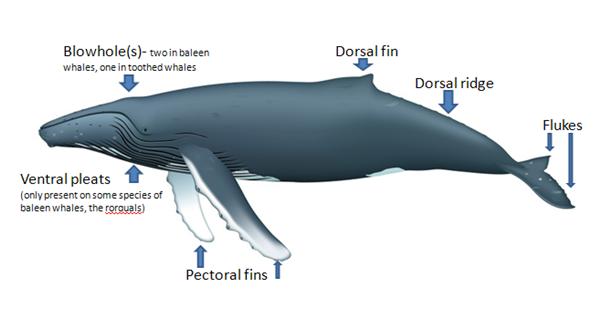 A) The Mysticeti, or baleen whales.
A) The Mysticeti, or baleen whales.
1. Minke Whale– The minke is the smallest of the baleen whales. They are roughly the size of an orca, and are dwarfed by the larger gray whales and humpback whales. Being so small, their blows are not always easily seen. Their bodies are small and torpedo-like, with small pectoral fins with a white band going across them. If you are lucky enough to see them breach, as we did, you can easily see this.

Note the smooth, torpedo-like shape. The white band on the pectoral fins is clearly visible, and the small pectorals are tucked in close to the body. The minke whale is part of the rorquals, so they do have ventral pleats. However, you have to be quite close to be able to distinguish these pleats.
Breaching is a rare thing to see in a minke; they are typically shy and elusive, so more frequently you only see their back and dorsal fin. No fear though, as the minke dorsal fin is also fairly easy to distinguish from other cetaceans in the Salish Sea. As with all baleen whales, the dorsal sits about 2/3 of the way back on the body, so it is preceded by a fair amount of back before the dorsal fin can be seen. The dorsal is small and distinctively curved.

Another thing to look for in minkes is lunging behavior. These whales often lunge feed; they create a bait ball and then lunge through the middle and can sometimes come partly out of the water. Minke whales are perhaps easiest to confuse with fin whales. While these guys are rare visitors to the Salish Sea, it is still worth noting the difference, as they are sometimes seen here. Fins also have small, hooked dorsals that look quite similar to minkes. However, the fin whale tops out at around 80 feet, and is the second largest creature on earth. This is much bigger than the 30 foot minke. While it can be tricky to distinguish from a distance, size is the key feature to look for in this case.
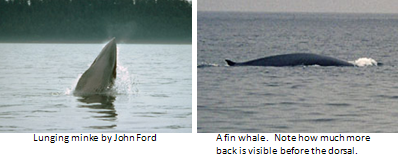
Minke whales are known to make “boing” sounds. Most of the energy in these calls is between 1 and 2 kHz, which is well within the hearing range of humans. An example of their call can be heard here.
2. Humpback Whale– Humpbacks are larger (between 40-50 feet) members of the baleen whale family. When you know what you are looking for, humpbacks are pretty easy to distinguish from other species of cetaceans. Their blow is usually more visible than the blow of a minke. See the picture below to note what to look for in the blow.
Humpbacks are also known for being one of most acrobatic of the whales. They frequently breach, spy hop, slap their pectorals, and slap their flukes. If you see a whale doing any of these behaviors, look closely. The most obvious feature of the humpback whale is its pectoral fins. Their scientific name, Megaptera novaeangliae, literally means “large-winged New Englander.” Long and often white, the pectorals are very obvious and are a dead giveaway that you are looking at a humpback.
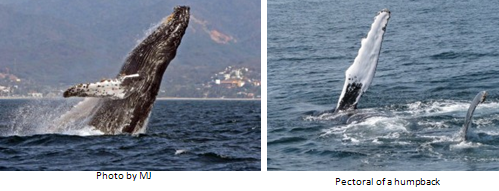
Humpback whales are also known to fluke, which is when they deep dive and show their tails. All the whales have distinct white patterns on the underside of their flukes. These patterns are used to identify individual whales. Minke whales do not usually show their flukes. Gray whales do on occasion, but humpback whale tails are distinct in shape.
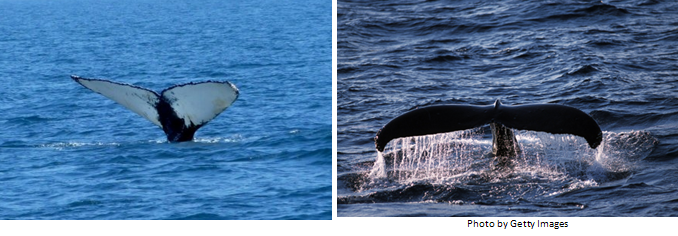
If you only see the dorsal fin of the whale in question, it is also fairly easy to tell which kind of whale it is, especially if you get a picture! Humpback dorsal fins have a small bump in the front and then a sickle-shaped curve. They are also well-known for “humping” their backs right before they dive.
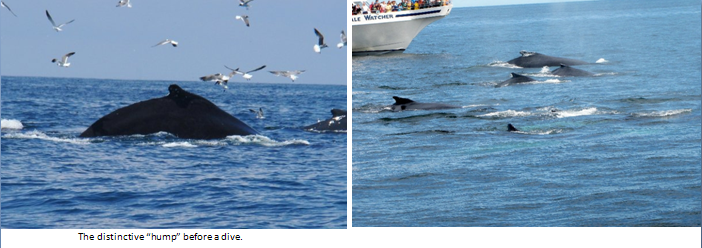
Humpbacks are known for being very vocal, and males compose long, haunting songs that carry for miles. An example of a humpback song can be found here. However, these songs are sung primarily at the breeding grounds of humpbacks, presumably to attract mates, although this isn’t known for sure. Humpbacks found in the Salish Sea are more likely to be making a feeding call.
3. Gray Whale– Gray whales are rather prehistoric looking whales that can be found in the spring, summer and fall in the Salish Sea. These whales like to feed along the bottom in shallow waters, and so are frequently seen foraging close to shore. They are covered in barnacles and whale lice. These patches of parasites can help distinguish individuals.  The blows of gray whales are bushy and heart-shaped.
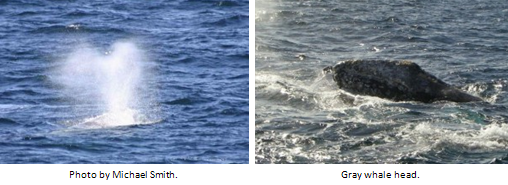
Gray whales also don’t have a dorsal fin, instead they have a prominent dorsal ridge.
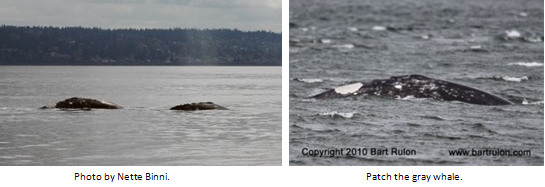
Gray whales tend to roll on their side and scrape along the muddy bottom in search of food. Because they feed in shallow water, this often exposes their pectoral fin. They also sometimes show their flukes, which are smaller and more square-shaped than those of humpbacks.
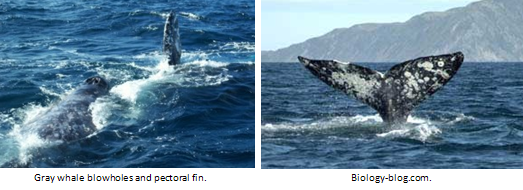
If you wish to try to identify a gray whale that you spotted, check out the gray whale ID guide from Cascadia Research Collective.
The vocalizations of gray whales are typically series of grunts. The average frequency is typically around or below 1 kHz.
A quick comparison of these three most common species of baleen whales found in the Salish Sea:

B. The Odontoceti, or toothed whales
1. Killer Whale, or orca- The orca is the most easily distinguished cetacean in the Salish Sea. Actually the largest member of the Dolphin family, the orca can be recognized by it’s black and white color pattern. Males sport dorsal fins up to six feet tall, while females have smaller, curved dorsal fins. The gray saddle patch behind the dorsal fin can be used to identify individual killer whales.
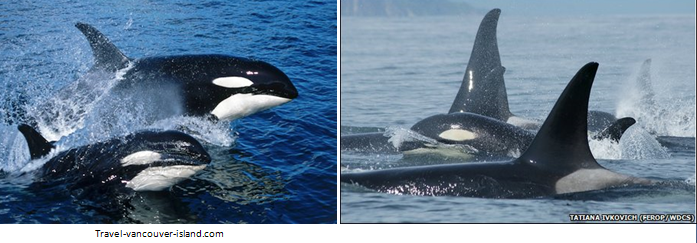
Of the three ecotypes of killer whales (residents, transients, and offshores), only residents and transients are found with any regularity in the waters of the Salish Sea. While it can be difficult to distinguish these two, it is not impossible. The southern residents (SRKWs) are found in relatively large, stable family pods, while transients are typically (but not always) found in smaller pods. Of course, the SRKWs eat only fish, while the transients prey on marine mammals. So if you see a killer whale pursuing a sea lion or other mammal, it is a transient. Transients and residents can also be distinguished by their dorsal fins and saddle patches. The SRKWs have more rounded dorsal fins than transients, and they can have open saddle patches, while the transients have solid gray saddle patches. Residents and transients can also be distinguished by their calls. Residents are much more vocal, and tend to have an almost up-beat, bubbly sound to their calls. Transients typically make fewer vocalizations that have a rather haunting quality to them.

2. Pacific White-sided Dolphin- While Pacific white-sided dolphins aren’t seen frequently in the Salish Sea, they are seen at times during the summer and fall. These dolphins are relatively small, around eight feet long. They have a dark upper body, with a light underside and gray stripes running along their sides. They also tend to show more of their bodies when surfacing than the porpoise species found in the Salish Sea. They make high frequency, whistle-like vocalizations.
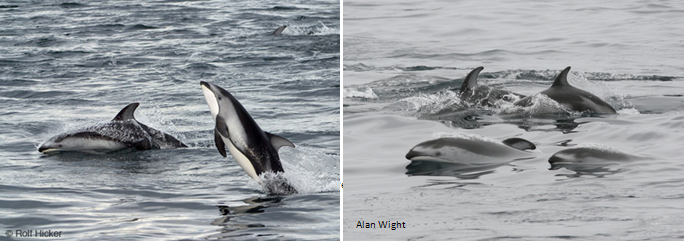
3. Harbor Porpoise- Harbor porpoises are small members of the Phocoenidae family. They are gray-brown on top with a light underside. They have a triangular fin. Harbor porpoises are often seen in fairly shallow water, and can be found around the mouths of rivers. They are typically found in small groups of less than ten individuals. Harbor porpoises typically make acoustic signals that are above the hearing range of humans, but it is possible to slow the calls down to allow humans to hear them.

4. Dall’s Porpoise- Dall’s porpoises have a black and white coloration that is similar to that of orcas, leading to them occasionally being incorrectly referred to as baby orcas. Measuring around 6 feet, the lack of an eye patch and shape of the dorsal fin immediately give the animal away as being a Dall’s porpoise rather than an orca. Dall’s porpoise are very fast cetaceans, and often create a “rooster tail” of spray when bow-riding. They have a small white patch on their triangular dorsal fin, helping to distinguish them from harbor porpoises. They are stockier than harbor porpoises, with a narrow, distinct peduncle (area immediately in front of tail). Like harbor porpoises, Dall’s porpoise produce acoustic signals that are too high for most humans to hear. However, when brought down to a frequency within our hearing range, they make a series of click-like sounds. Scripps Whale Acoustic Lab has a nice recording of a Dall’s porpoise here (For whatever reason I can’t link directly to it, so click on Porpoises, Dall’s porpoise, and then play call).
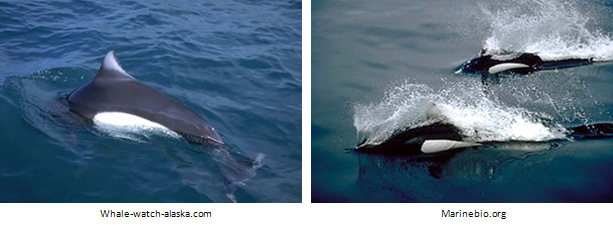
Comparison of toothed whales found in the Salish Sea:
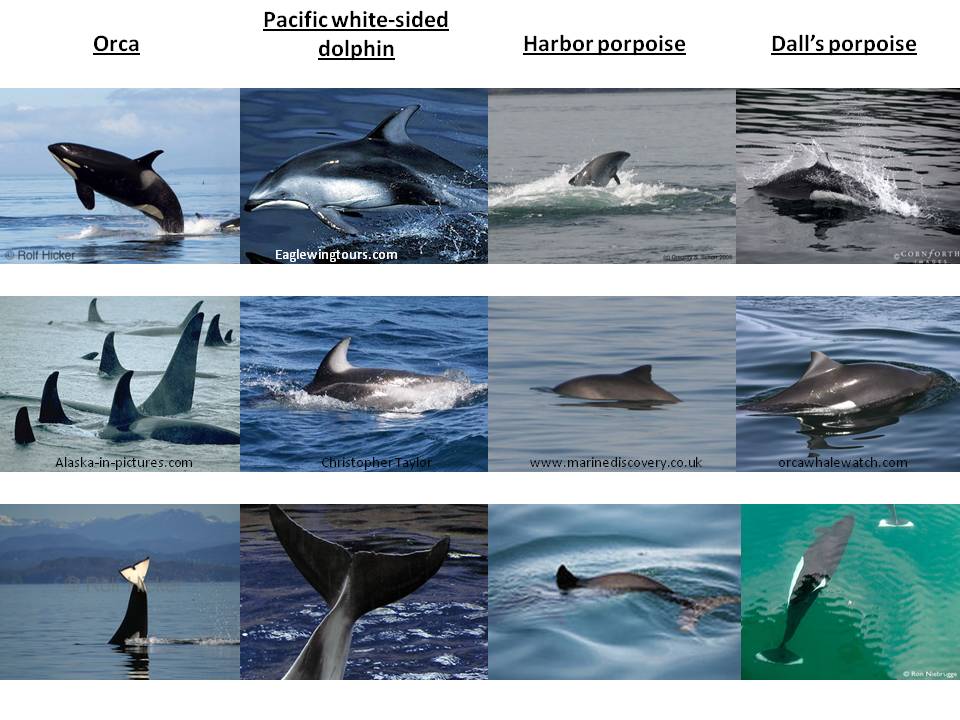 Well that about wraps it up for the cetaceans of the Salish Sea! I hope that this helps provide a guide for identification of the cetaceans in this area.
Well that about wraps it up for the cetaceans of the Salish Sea! I hope that this helps provide a guide for identification of the cetaceans in this area.
On a quick side note, I would like to thank everyone who was on the Gato Verde with us this past week, and give a special thanks to Val and Leslie for cooking us a fantastic Easter brunch and letting the Easter Bunny into S1 to hide chocolate eggs for all of us! 
Also, while writing this blog post, I was interrupted by orca calls on the Lime Kiln hydrophones. Carlos was super nice and drove us all down to Lime Kiln, where we got our first sighting of J Pod!!! It was extremely exciting, probably one of the best days of my life. One whale even breached right off shore from us twice! I’d like to leave you all with this photo of a whale porpoising by us at LK. Jeanne was also watching from shore; she got some IDs and posted a recording of the calls on her blog!
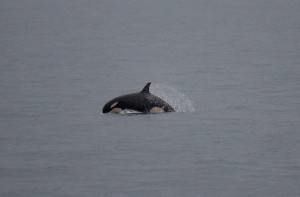


Read More
 We learned about how they avoid using nonrenewable resources, chemicals and other artificial substances in order to efficiently grow their crops. It got even more interesting when the owner would tell us about other organic farmers that have made 100’s of people food from just a small acre of land using permaculture practices. Permaculture is a sustainable land use design that is based on natural ecology. This design uses what is available in nature in order to maximize the use of the land, minimize the work needed to maintain it, and restore the environment. At first I speculated whether or not this method could actually supply a large sum of people enough food for a few months. She made me more of a believer by sharing more stories of other farmers who have been successful in this field of agriculture. Supposedly in Paris a small plot of land using the permaculture design was able feed the whole city! How amazing is that? I can’t recall the name book that claimed this incredible story as true, but if you want proof I could go back and find out! This made me even more interested in her farm and way of living. It seemed so different from the norm and exactly the way farming should be. She also made her own ointments, lotions and tea from an herbal garden next to her house. All of these self sustainable practices definitely sparked my own thoughts about creating an organic garden that I could live off of and be comforted by the fact I would be contributing to instead of harming the environment.
We learned about how they avoid using nonrenewable resources, chemicals and other artificial substances in order to efficiently grow their crops. It got even more interesting when the owner would tell us about other organic farmers that have made 100’s of people food from just a small acre of land using permaculture practices. Permaculture is a sustainable land use design that is based on natural ecology. This design uses what is available in nature in order to maximize the use of the land, minimize the work needed to maintain it, and restore the environment. At first I speculated whether or not this method could actually supply a large sum of people enough food for a few months. She made me more of a believer by sharing more stories of other farmers who have been successful in this field of agriculture. Supposedly in Paris a small plot of land using the permaculture design was able feed the whole city! How amazing is that? I can’t recall the name book that claimed this incredible story as true, but if you want proof I could go back and find out! This made me even more interested in her farm and way of living. It seemed so different from the norm and exactly the way farming should be. She also made her own ointments, lotions and tea from an herbal garden next to her house. All of these self sustainable practices definitely sparked my own thoughts about creating an organic garden that I could live off of and be comforted by the fact I would be contributing to instead of harming the environment.

























 Twitter
Twitter LinkedIn
LinkedIn Facebook
Facebook